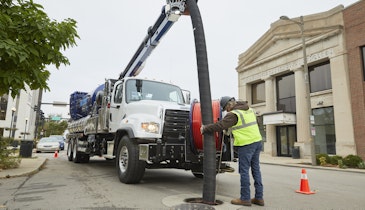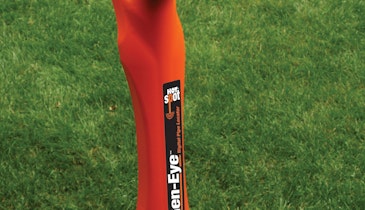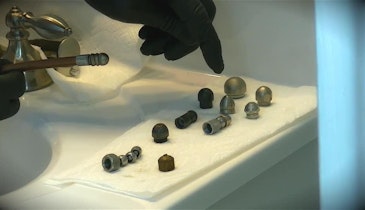
Interested in Inspection?
Get Inspection articles, news and videos right in your inbox! Sign up now.
Inspection + Get AlertsYou shimmy into cramped trench boxes and maneuver heavy equipment into tight quarters, all in the name of pipe bursting. The no-dig pipe replacement process is gaining more and more interest from contractors nationwide, and you’re leading the effort to tackle the toughest pipe bursting jobs on a daily basis.
Your out-of-the-box bursting stories encourage other contractors to take the pipe bursting plunge, so we wanted to take a closer look at some of your toughest jobs.
In no particular order, here are five of the toughest pipe bursting jobs that have graced the pages of Cleaner:
1. Mission impossible? We think not.
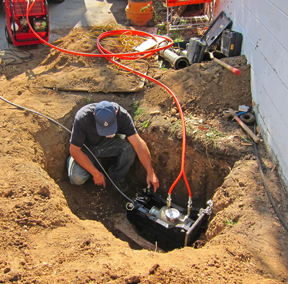 Chronic backups, plumbing fixtures that never drained, and the overwhelming odor of sewage rendered the original section of an 80-year-old home in Gilroy, Calif., unlivable.
Chronic backups, plumbing fixtures that never drained, and the overwhelming odor of sewage rendered the original section of an 80-year-old home in Gilroy, Calif., unlivable.
Plumbing America to the rescue! “We built our reputation on solving the impossible,” says owner Scott Thompson. The company got to put a new pipe bursting system to work on the severely misaligned lateral.
A previous plumber discovered that the homeowners had built an addition with a deck and detached garage over almost 100 feet of the 4-inch vitrified clay lateral, and it was clogged with tree roots. Since digging up the line was out of the question, the contractor deemed the condition hopeless and walked away.
Thompson’s crew of four used a Gen-Eye 2 camera system with digital locator from General Pipe Cleaners to inspect the lateral.
Thick green root balls made the pipe interior look like a lawn. “I have never seen such a massive case of root intrusion in my life,” Thompson says.
Using a 320 Bobcat mini excavator, crew members dug the pulling pit on the far side of the garage and set the 40-ton pipe bursting system with 1-inch-thick resistance plate from RODDIE Inc. A 10 gpm/3,000 psi Quest Hydraulics pump powered the PB-40 ram with 31 tons of pulling force and 21 square inches of piston area.
Learn how this hopeless job earned Plumbing America an A+ for innovation.
2. Stripped down to the bursting basics.
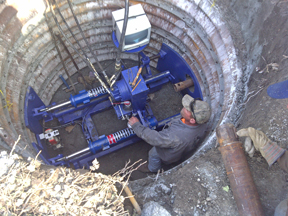 A tunneling machine had to help save the day for this contractor who had to replace lateral lines and restore sewer service to a strip mall in Santa Cruz, Calif. Sand leaching into a corroded 4-inch cast iron lateral caused backups into multiple businesses.
A tunneling machine had to help save the day for this contractor who had to replace lateral lines and restore sewer service to a strip mall in Santa Cruz, Calif. Sand leaching into a corroded 4-inch cast iron lateral caused backups into multiple businesses.
A local contractor tried clearing the 130-foot line with cutters on cable machines for more than a year and as often as three times per month, but to no avail.
As the health department and tenants’ patience expired, the contractor called subcontractor Roddie Underground Construction and its RODDIE UB-40 tunneling machine to install a 4-inch HDPE lateral under the mall without affecting customer access.
With a reputation for replacing sewer lines in difficult situations, Roddie was up to the challenge.
From a manhole, a worker televised the pipe using a GatorCam3+ from Radiodetection, and took sonde measurements to plot the line’s location.
To prevent the drilling machine from moving, crews steadied it inside a 6.5-foot-diameter corrugated steel casing. That in itself is a tough job!
Find out if working morning and evenings when the strip mall was closed paid off for this contractor.
3. Sensitive areas call for top-notch subs.
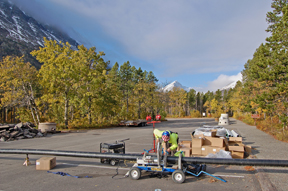 When Glacier National Park in Columbia Falls, Mont., fell victim to failing wastewater infrastructure, the National Park Service called in the big guns.
When Glacier National Park in Columbia Falls, Mont., fell victim to failing wastewater infrastructure, the National Park Service called in the big guns.
HK Contractors in Idaho Falls, Idaho, won the bid for general contractor. HK hired only subcontractors with extensive experience working in sensitive areas.
“We were selected to pipe burst 2,000 feet of 6-inch mains,” says John Galligan, co-owner of Pipeshark in Elverson, Pa. “The contractor who cleaned and inspected them reported mostly terra cotta with some cast iron pipe.”
A tightened work schedule, inclement weather, undocumented obstructions and stringent park environmental rules made this job a doozy.
Galligan planned to transport his TRIC pipe bursting system 2,300 miles to Montana, but delays and heavy snowfall put the kibosh on that. “We had to get there fast, then rent equipment,” he says.
Galligan wanted to rent TRIC equipment from a local contractor or distributor, but found none in Montana. Rod Herrick, owner of Roddie Underground, loaned him a RODDIE system — an R2 pipe bursting machine, portable hydraulic power pack, compact fusion welder and a John Deere D50 compact excavator.
“This was the company’s Super Bowl — our chance to put all our skills on the line to meet the challenges,” Galligan says.
Find out if these pipe bursting gurus were able to take home the Vince Lombardi trophy for a trenchless win.
4. A crash course in pipe bursting.
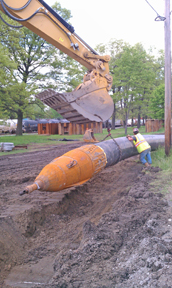 Talk about on-the-job training. City officials in Windsor, Ontario, had to rely on a company with no pipe bursting experience to tackle a job no one else would touch.
Talk about on-the-job training. City officials in Windsor, Ontario, had to rely on a company with no pipe bursting experience to tackle a job no one else would touch.
After no one responded to RFPs for directional drilling, two firms finally submitted bids to pipe burst and upsize a 27-inch concrete gravity sewer that taxed the capacity of the wastewater treatment plant during heavy rains.
Corrosion from hydrogen sulfide also took a toll on the pipe in many places. The sewer’s imminent failure kicked the work into high gear.
Local SLR Contracting Group won the bid. Although the company had extensive sewer and water main experience, it had never burst pipe, and crews had to learn on a site with multiple challenges. With guidance from Midwest Trenchless Services in Grant, Mich., SLR crews received a crash course in pipe bursting.
Crews used John Deere 290 and Caterpillar 336 excavators to lower a bursting head, skirt expander and 32-inch HDPE pipe into a shoring box.
Another obstacle? The job required sheet piling to be driven alongside the closed lane of a four-lane parkway to protect the road from the force of the pull-backs.
SLR believes it also set a U.S. and Canadian record for the longest pull of 32-inch pipe – 570 feet.
The result of this unwanted job is something you have to see to believe.
5. Look mom, no hands!
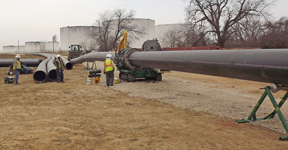 Preserve a playground, a concrete trail and as many trees as possible. Go! Pipe bursting was the only option for officials in Forth Worth, Texas, to upsize a 24-inch reinforced concrete sewer interceptor to accommodate projected development.
Preserve a playground, a concrete trail and as many trees as possible. Go! Pipe bursting was the only option for officials in Forth Worth, Texas, to upsize a 24-inch reinforced concrete sewer interceptor to accommodate projected development.
No-DigTec of Dallas won the bid to install 1,175 feet of 28-inch, 1,826 feet of 32-inch, and 260 feet of 34-inch DR-17 HDPE pipe.
Root intrusion, bellies and offset joints also caused headaches.
One problem. A huge bursting head and the weight of the 43-year-old pipe made moving parts and equipment by hand impossible.
“The 34-inch bursts were a first for HammerHead Trenchless Equipment and us,” says No-DigTec owner John Newell. “Besides logistical and site challenges, upsizing the bursting head five times and the weight of the pipe — 2 tons per 50-foot stick — stressed men and equipment. There was nothing we could move by hand.”
A 10-member crew used a McElroy TracStar 900 self-contained fusing machine to weld 20-foot-long sticks of 32-inch DR-17 HDPE pipe, and a 38-inch expander head, a 26-inch pneumatic Mole rammer driving at 122 beats per minute and the lubrication system from HammerHead.
The city even had to call in an arborist to grub out 15-foot-wide paths and trim or cut down trees because workers were hacking their way through underbrush with machetes. Yikes!

